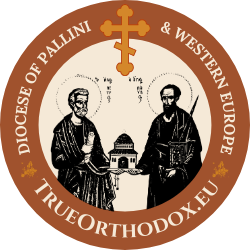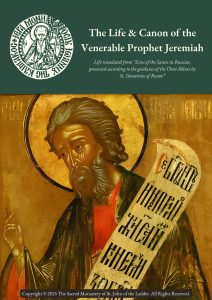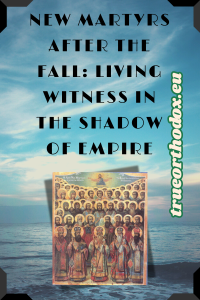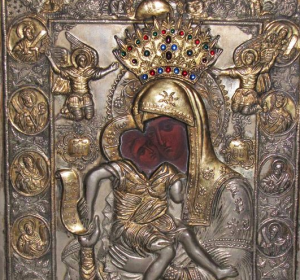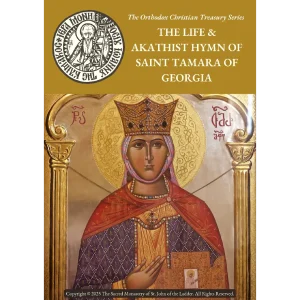THE SPIRITUAL STATE OF THE CONTEMPORARY WORLD
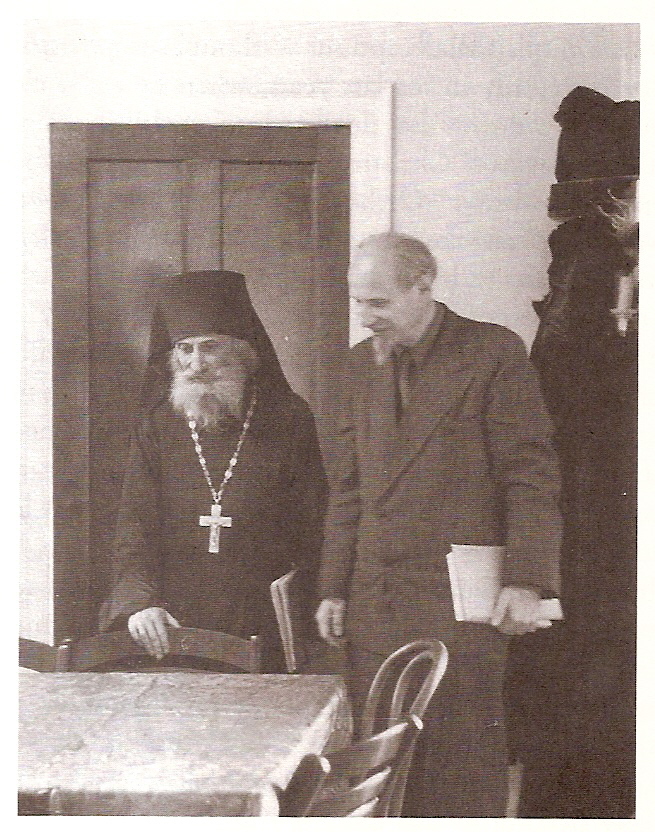
published in Orthodox Life magazine 1960 (4)

by Archimandrite Constantine Zaitsev
THE SPIRITUAL STATE OF THE CONTEMPORARY WORLD
Intervene, save, have mercy, and preserve us, O Lord, through Thy grace.
As an epigraph, I have used the appeal of a liturgical prayer, which nothing else can surpass in conveying the impression that is being made by the spiritual state of the contemporary world. For it may be said point-blank: the world shows a tremendous progressing movement in the direction of its end.
It is characteristic of man to waive aside such an approach to events: how many times already has the end of the world been spoken of, but here it stills stands! And it was characteristic also of me to respond in like manner to talk filled with eschatological alarm. Suddenly I saw it all clear!
This took place in Harbin. During summer I remained alone – my wife departed. Once on a holiday, after I had taken Communion, I returned to my dwelling and suddenly, I don’t know why, something dawned on me – I took the Bible and, on the spot, without interruption, read through all the principal parts of the Bible that related to the Second Coming. And right there I said to myself. Yes, – all is clear. The world is going towards its end. All the problems that were present in my consciousness – ceased being so. Art, science, social life, the history of humanity, church life – all received a distinct explanation in the perspective which suddenly opened before me. From that time there was not a moment when I could doubt it. This does not mean that one has to accept the Second Coming as something irreversible. As it was in times past, so is it possible that now this expectation also will not be realized. Does it mean that the expectation in those old times was not justified? No. It means only that the hand of God was withdrawn. And it may now be withdrawn. Our eschatological perception is not a resignation before fatalism. It means only that we do not any more speak abstractly of the possibility of a mere end coming to the world, infinitely removed from us; but that we accept as possible that the Last Judgement is capable of becoming a direct answer of God’s Truth to the presently observed self-affirmation of the world in evil. For if annulled is the sole basis through which the New Testament world exists, that is, if humanity has ceased accepting towards its own benefit the world-saving sacrifice of our Lord Jesus Christ, then, for a Christian consciousness, the immediate trend of such a world’s course towards the end is an axiom.
From this point of view then it is possible to say: each elapsing year is noticeably bringing us closer to the Last Judgement. It is showing a progressive paralysis of the human will to be saved. And this is not only a departure from the faith, but a modification of Christian faith in the sense of its dechurchification. Salvation outside the Church is incomprehensible – this also is an axiom of Church consciousness. Expressly, we see deterioration, ruin, derangement, depersonalization, and fading of Churchness. Is this not proof of the maturation of a perishing world? Orthodoxy, Catholicism, Protestantism – the historical triunity of Christianity has turned out to be ill with the very same malady – infidelity to the Church, reaching to utter disrespectful negligence towards Her and even to the ideological denial of Her original essence.
A beginning to our pre-Antichrist epoch that is currently being lived through has been given by the fall of Russia – that is to say, by the doing away with in the world of the Restraining power, with Satan being set free from his temporary (“one thousand years,” as this period has been conditionally called by the Scriptures) bondage. It is one thing to evaluate the causes of this catastrophe. Here it is evident to Church consciousness that it came about as a result of the dechurchification of our Homeland. It is another thing to evaluate how this catastrophe actually progresses and what its ostensible results are. It brought forth a saving reaction: the great vitality of Russian holiness was manifested. If the New Testament Church has arisen upon the blood of martyrs, then this blood was again shed in abundance by martyrs in the Russian Land. One would expect that it should enrich it towards a new flowering of churchness. The brightest hopes were justified. Did it not seem that through this blood the Church anathema hanging over the Soviet Church and all connected with her in spirit could be vengefully satiated. Could not this blood compel a saving grant of wings to all spiritually reborn to renewed life within the True Church? Did not this promise the arising of a new epoch when the Caine generation who seized Russia had to seek safety in flight shaking and groaning? Why did nothing of a sort take place? The year 1927 was a fateful date. Orthodox Russia split. One part became “legalized.” It exchanged enduring of a Soviet yoke for a compliant legal recognition of illegal Soviet authority, having given away the Church not only to control by Soviet Satanocracy, but even beneath its dominion. Through this the other part of it, the True Church, of necessity drank to the bottom the cup of martyrdom, being forced for the sake of prolonging its existence to withdraw into the catacombs. But all this satanic maneuvering did not free the legalized Church of extreme forms of miseries and sorrows. Terrible destruction and extermination visited the external Church – but was this “lawful” martyrdom? Only through God’s mercy could it go towards a personal salvation of some of the repentant sufferers.
The conditions of the Second World War radically changed matters, bringing about sympathetic attention on the part of the Bolsheviks towards the remnants of the Church. There began a relative flowering of the Church under the watchful eye of Soviet Satanocracy. From that moment the so-called Soviet Church began to appear with ever-increasing distinctiveness in two evil-conveying forms. Inwardly progressed the process of “Sovietization” of the clergy, which more and more transformed that sole thing left to the Church, that is to say, the Church service and the sacraments limited by the space of the church itself, into something unauthentic, artificial, falsified. Outwardly, on the other hand, the Church made its appearance with an utterly false countenance, carrying out a most responsible Soviet assignment upon whose course the fate of literally the whole universe depends. The Soviet Church is compelled to lay paths of goodwill voluntary association between the Red Kremlin and all the Churches of the free world, and through this with the whole free social life of the world. If in its internal life the Soviet Church is only becoming an anti-Church through a certain “process,” which manifests itself as something which we knowingly accept as something complex, then externally the Soviet Church does not appear ambiguous at all: in its universe-organizing qualification, in its universally-maneuvering satanic assignment, it is an anti-Church in its full 100%.
In thus a manner arose that something terrible which with certain justification can be called a spiritual NEP,* and which is capable of transforming the martyr blood which has abundantly bedewed the Russian Land, from the promise of a saving rebirth through it towards a new historical life, into fragrant incense vapor of martyr blood rising to Heaven to invoke God to vengeance.
(* New Economic Politics proclaimed by the Soviets in the twenties, having as its aim to provoke all latently existing elements of a social life to the surface in order to eliminate them.)
The successes of this spiritual NEP are manifested namely with each succeeding year. Analogous processes different in nature, but moving in the same direction are taking place in the free world.
The forestage of church-social life is occupied by so-called ecumenism. Its task is to unify Christianity through a horizontal agreement, with a devaluation of any historical churchness. Openly the task is not posed as one of giving rise to some Super-Church. This would scare away everybody. This would be infeasible anyway. Ecumenism has no Church constructive capacities. But in the scheme of destruction, its opportunities are tremendous. And this all the more so, since in its destructive activity the ecumenistic movement is leaning on general strivings peculiar to our age.
One can distinguish two pernicious ideas here. The first, is the negation of the Church as an unrepeatable historical entity, as the Body of Christ, with the resultant transformation of churchness into a matter of free agreement, inspired by self-willed fancy. The second, is the transformation of Christianity into an entity of this world, with the resultant transformation of even its final attainments into something unifying humanity on earth, and elimination of the perspective of a twofold Eternity, that of blessedness or damnation, and substituting the Last Judgement to be carried out by Christ the Remunerator by a peaceful Christ once more coming to earth. These trends far removed from Christianity are a circulating coin of contemporary Christian idealogy and are only clothed in vestments of Christian phraseology. Religious journals are ready purposely to stress their interconfessionalism. As to the general press, it long ago already has lost any Church countenance. Catholics, Protestants, and Jews work together on the same editing committees of the religious press. Barriers have been removed. Heaven surely does not know them! But here heaven itself is denounced. Let us present some examples.
In the contemporary Protestant world, whom can one regard as the most influential representatives of modernism in religion? A movement with a characteristic name is beginning to penetrate into America. Religious revival is noted to be “worldly,” lay, and this not in the sense of a strengthening of the influence of laymen (such a tendency we observe even in Catholics), but in the sense of the formation of some interdenominational “tiers etat,” subverting historical churchness. For instance, we can name a certain German pastor Bonhoefen who ended his young life as a martyr, as a professor of faith in Nazi prisons. At the present time his teaching, as reflected in his letters, is gaining in popularity. The traditional Church with its belief in life in the hereafter and with its stand on the eternal life of the soul seems for him to have outlived itself. Now man has no need of “final questions” – the earthly incarnation of Christ exhausts the spiritual horizon of the Church; Christianity has to become more worldly, including all that exists on earth, be whatsoever it may. The old type of Church – is out of place. One current writer compares it to an old-style personality who has appeared at a contemporary party: everybody is polite to her, but each one asks himself, why really has she come if both her appearance and speaking are alien to everybody. For Christ’s sake, the Church has to become “contemporary,” including in itself all social matters and fusing with them. At evangelical academies in Germany, conventions are formed with the participation of scientists, politicians, men of war, workers, teachers of dancing, etc. – the general atmosphere is created in bold supposition, that everything existing in the world – is inclusive in Christ. In Sweden, Olaf Hartmann writes plays, speaks on literary themes, attracts writers to his splendid villa, where he “treats” them to a liturgy, which is served by persons “professionally” called to it, but accompanied by his interpretation: he wants to see the flame of the New Testament intensified by a wind of contemporariness. In Scotland, a certain community is attracting people toward a common service to God under the guise of a unification of all phases of life beneath the protection of the Gospel. The head of this community, McLeod, renounces Divine Revelation: life itself reveals Christianity, and the contemporary man, in his “totality” is blessed by God Himself to burn with a social passion. The cross has to be carried by the Church at the crossroads, appealing to the whole man, by which self-denying love is not negated. Such a “lay” movement is also finding support in the World Council of Churches, fusing with its organization of “laymen” whose task is to form a new “people of God.”
In a Christian manner to take possession of life in its totality, even though for this it would be necessary to transform all of Christianity – such is the ideal task of this movement. It is also not alien to Catholicism. A characterization of a similar “mentality” is given by one French Catholic journal. All that is transcendental, all tradition, hierarchy, rules of faith, value of the Sacrament namely as a mystery, the conception of sin, commandments: all that is discarded. On the other hand, it is demanded that the activity of the Church in the world be evinced in full strength – in it is seen the incarnation of the mystical Body. The temporary has to receive a full value – the Gospel is exhausted by the demands of the doing of good deeds, self-denial, and poverty.
As a highly idealistic live example of such a trend can serve the image of the priest-worker, Perrin, whose letters, made known to the public, also have attracted wide attention, in part, as a result of his tragic fate: he became a victim of a traffic catastrophe… Before us is a live, energetic, self-sacrificing active Church worker, a Jesuit from the start who left the order to wholely give himself over to serving society – in forms, earlier not imaginable. Concealing his Church office, he lives in a workers’ environment, which has completely withdrawn from Christ and at best already relating itself to Him not differently than to Buddha, and a significant part steeped in materialism and Communism. But if once barbarians were brought to Church unity – why not now baptize communists! With his whole heart, Perrin plunges into the life of the workers, actively including himself in strikes, passing through with indignation to the capitalists. He in no way differs from the environment – he lives in a room which has crude pictures hung up about it, he strums the guitar, etc. He leaves when the order comes from higher up, but with the conviction that here blindness has been displayed… And here the catastrophe overtakes him. Outside of dispute is the idealistic direction of Perrin, but the disposition of his consciousness is the same as we characterized above: that it is necessary to “socialize” Christianity, making it accessible to the contemporary stream of life – in all its dechristianization…
Here is another illustration which already concerns an environment independent of its confessional origin. “An astounding investigation” – such is the title borne by an article in a German Catholic journal, dedicated to the “misery of youthful woman workers” in Germany. In all, she has 9 million woman workers. The investigation concerned the youngest ones: 350 girls were questioned. Characteristic for all of them is that none of them went to the factory “consciously”: “The parents had need of money for new rooms”; “I wanted to care for children, but father wanted me to bring earnings right away”; “I did not know how to occupy myself.” Right from the school bench a half-child gets into a factory. There is no complaining, but feeling of bitterness. The first impressions are conveyed with horror: noise, filth, stench, unbearable weariness. “Why were we not told earlier what a factory is like?” Some are close to mental derangement. Some bewail unrestrainedly, having gotten into a conveyor. And the rudeness about her! “A wild horde!” Not to speak of the stories of married women – what do they reveal? But one must adjust – and there arises the custom of bold self-assertion: let’s be like everybody else! Two-three years pass, and the 18-year-old says: “I am already old, in order to change anything, to begin life anew.” Routine dulls. There is no individual life, everything is “like everybody” – as in vulgar novels, – as in the movies. Only not to have the obligation of becoming thoughtful over anything – no “problems.” There are three groups with regard to religion. An insignificant minority of firm believers – 10-12 girls, indebted for this to somebody at home or in the Church. Twice as many are bitterly anti-clerical. The rest are lukewarm: one must nevertheless believe in something – but is it possible to take this seriously?; weddings, baptisms – here is a tie with the Church. Each one has a “friend” – for, one has to be “as everybody”! As to marriages, they in general think seriously concerning marriage, this is some kind of a way out…
These girls are abandoned – what will they give to life? And yet these are millions! The Church is inattentive to them…
The Catholic Church! Within the Church itself ruinous processes are taking place. A Catholic dechurchification is being manifested, on the one hand, in forms related to common life, and that in forms specific for our age: modernization. Ruinous is the imitation of rehabilitated Orthodoxy: since it is “imitation” it is difficult to expect grace here. And in the conscience of the church folk it is felt to be a violation, vacillation, even an insult to prayerfully-endowed ancientness. As to modernization, it is shaking loose the abutments of the Church. Such a natural reform as the “delatinization” of the church service is accepted with disfavor. And what can one say as far as weakening of Church discipline is concerned? Or the lowering of the Eucharist lent?

The other phase of dechurchification is more substantial…
Before us is the problem of Catholic “ecumenism,” now receiving a radical resolution in the form of the “universal” sobor of Pope John XXIII. In order to realize the vastness in significance of that which has been done, it is necessary to start thinking about the so-called “Apostasy.”
All manifestations of “apostasy,” not having crossed the boundary established by Apostle and Evangelist John the Divine, that is to say, not denying the divine nature of Christ, bear the stamp of duality. They are not ultimately excluded from the graceful bosom of the Church and, to the extent to which these sprouts of Christian root strive toward Christ, somehow they also are saved even in this Christian detriment of theirs, being covered over by the mercy of God. Even those who have withdrawn can be referred to the assuring words of the Saviour: “He who comes to Me, I will not exclude.” But for this, it is necessary that there actually be a striving towards God of the remains of their Church consciousness. Such mercy of God, of course, is turned to the greatest extent towards Catholicism, which, of the religions involved, has preserved the greatest degree of nearness to the original true Christianity. But namely for Catholicism is it most difficult to withstand the temptation of keeping a complete aloofness of consciousness in its appeal to Christ – without taking up a blasphemous turn against Orthodoxy, which is rejected by them. And as far as Catholicism raises its hand against Orthodoxy, then it is going not toward Christ, but against Him, manifesting that “Anti-Christ” which is inescapably present in any “apostasy.” It is not mercy but righteous wrath that is natural a response of God to such a direction of Catholicism which simultaneously imposes a ruinous duplicity on its whole countenance.
Up until recently the task of struggling with Orthodoxy did not characterize the consciousness of Catholicism as a whole. At the upper levels, something in this direction was being done, at the periphery, something was taking place, somehow later something of a sort was consolidated into the Church life. But the main body of the faithful, in remaining within the fold of a Church essentially Christian in origin, does not burn with fanatical anger towards those whom the Roman Church abandoned in the bosom of the True Church. In historical Catholicism two elements are intertwined. Christ lives, be that due to apostasy He is manifested in a perverted form. But the Antichrist also lives, and also in one way or another manifests himself. However, never up until the latest time did the evil power overcome the power of Christ. Never did Catholicism identify itself wholely with anti-Orthodoxy.
This something “new” became apparent at the very same time when the Orthodox Church was going through the “Sergius” crisis, and incidentally it took place under conditions which, on the contrary, it would be expected should have called for a unification with the Orthodox – the Orthodoxy being persecuted. But Catholicism did not sense a spiritual kinship with them. It did not even raise a banner of struggle in the name of salvation of Catholics who shared the fates of the Orthodox. Something diametrically opposite took place. The Fatima vision of the Mother of God to Portuguese children was utilized in order this time in the name of the whole Catholic world to open a struggle with Orthodoxy – to its extinction. I can never forget a certain personal experience. In Paris, being on the staff of a Russian writing brotherhood, I happened to be in the Cathedral of the Virgin Mary during prayers for the salvation of Russia. How great was my astonishment when I heard prayers not for the Lord to help Russia to free herself from the web of the communists, but for the Lord to help Rome “convert” the Russians…
To the degree that Rome has entered upon a path of “converting” Russia, to that same degree has it been doomed to be in alliance with the communists. It has been doomed to derive advantages that would proceed from Russia being taken possession by them. It has been doomed to show itself in cunning duality even before the face of their brothers who suffered beneath the yoke of Communism. It has been doomed to share together with the Soviet Church a common path with Soviet authority – and through that very same to garb the Soviet Church in the vestments of true Orthodoxy and to seek a common path with falsified Orthodoxy…
In such a manner the evil Antichrist principle in contemporary Catholicism is assuming ever more acute form. But something else also has taken place: the Christian principle is reduced to nil… Let us seriously consider what the sobor of Pope John XXIII is.
This is not simply a sobor, bearing the pretentious title of “universal,” but referred to the Catholic world. This is – a sobor, according to tradition continuing the series of true universal sobors, and desiring to bring all of Christianity into unity.
The exact text of the pope’s declaration concerning the sobor is evident: this is – the call to unify beneath his hand. But informally calling all the different religions beneath his hand, the pope simultaneously opens to them the opportunity through agreement to establish the conditions of subservience. The Pope promises to forget the past, displaying the greatest of tolerance. In other words, it is proposed for all Churches to annul themselves in their graceful historical essence with the guarantee that they will have preserved the habitual content of their manner of worshipping God. It is that very same agreement as in Protestant ecumenism with its annulment of historical Church authority. However, there is a difference. Protestant ecumenism does not lose anything, being a Church vacuum, to which historical Church unities are drawn. Catholicism – is a historical reality. And now it is sacrificing this historical value to ecumenical dream. In giving “schismatics” equal place in “renewed” Catholicism, Rome is annulling its original historical value, making itself equal to the “schismatics” whom it has allowed to associate with itself: there is no more of Christ, in His original authenticity. There is only the Pope and beneath him different variants of the worship of God. The ecumenism annuls its own Roman Catholic Church past, which by right of succession ascends to the Hall of Pentecost. What remains is an ecumenistic dream resting on human agreement concerning the utilization of the different forms of worship of God. A clerical “social treaty”! (“Contrat social”).
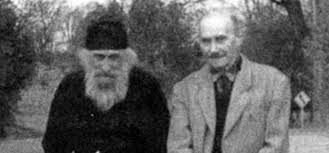
There is nothing more of Christ in this design – creeping and serpentining in its expressions, whose incomprehensibility is concealed by an outward appearance of good intention. Canceled also is the following condition: that the pope’s ecumenism is referred with friendly mien to an apparent Antichrist element – to the Soviets. The sobor of Pope John XXIII ignores the fact of the division of the world into two camps, being in struggle not for life, but unto death. Is not the task of protecting Christianity against Communism dictated to free and powerful Vatican? “Christians, whosoever you may be and howsoever you may believe, let us unify for defense and for liberating the world from the power that is threatening to overcome us all!” If the question of “unification” were to be set forth thus, how easy it would have been for everybody not only to go but even to rush forward towards meeting the call of the pope, in conscious recognition that in this everybody is realizing their service to Christ. However, on the contrary, the Vatican is also entering into an agreement with that Church power which outwardly represents the Soviets. The task earlier set for the Catholics remains in effect: to pray not for the overthrow of Communism but for the “conversion” of Russia. It turns out then that the Vatican is on the same level not only with Protestant ecumenism but also with Soviet ecumenism.
Here it is timely for us to give consideration to the church nature of the spiritual NEP, in its enticement not only enchanting those who, taking the path of the evil ones, willingly succumb to this enchantment, but also those who are ready to run towards a tiny flame of Orthodoxy that beckons to them, not accounting to themselves how deceitful evil can be, outflanking people “from the right.”
In order not to become a sacrifice to disinformation with regard to what is taking place in Russia on the religious front, one should first of all become confirmed in the following: that in the Soviet Union the lie rules in a totalitarian manner. Everything that is allowed to come through from the Soviet Paradise is imprinted with the mark of the lie. If something originating “from there” produces a definite impression, one, first of all, should consider whether the task of the entrepreneurs of information namely was to produce such an impression. The spiritual NEP has broad projects. I unexpectedly found interesting material for acquaintance with Soviet reality where one would have least expected to find it. This is an American book by a “specialist on religions” who already has written a series of books, and for this purpose having made up to forty informational excursions in company with his wife and co-worker, an experienced photographer. How could he not have gone to the Soviet Union – to the one land which set before itself as its primary task that of destroying religion? The book is written in literary style. The author possesses the capacity of perceiving authentic impressions. At the same time, his naivete surpasses all expectations. One is compelled to think that its manifestation namely permitted the author to become a valuable source of information – naivete forced out suspicion. The author did not betray their confidence; he presents the material in such a manner as it was conveyed to him, accepting all at face value. And this on the basis of a habitual ignorance, common to foreigners, with regard to past Russia and a like habitual and common infatuation with Soviet attainments. It would seem the book should have given that which the Bolsheviks wanted. But it turned out that the author also had trust in other perceptions, not only in those which were part of the intentional “show,” but also in those that accidentally and unexpectedly arose in its course. It turned out he had a sense of truth which manifested a fortunate trust parallel to the trust in the “show.” And so it turns out to be a real conglomeration. It is not difficult however to make out the Soviet “show,” and next to it – a whole collection of sparklers which after having been collected give one an unexpected picture that bases itself – and here one is compelled to render justice to the author – to authentic human intuition and sincere readiness to seek out the truth. As a result, the book God and the Soviets, written by Dr. Marcus Bach and edited in 1958, turns out to be a source of invaluable instruction.
Two series of phenomena open before us. Faith exists – an authentic, real, true faith. And this in two forms. The old, primal, Church faith as a way of life lives. This faith reveals itself in short strokes throughout the book. It manifests itself in the “people” with whom our tourist with a specialized task seeks to make contact. It manifests itself also in association even with “the servants of the cult,” with whom, of course, the author converses very frequently at length, and carries them through to the end by his naively-persistent curiosity, completely ignoring the relation of the conversant not only with the general conditions of life, but also with the certain presence of an observer.
The author obtains an old ikon that attracts his eye. One has actually to see in order to know the sensation that is called forth about it. The reverent attention of the crowd is followed by the very same interest on the part of the servants on the ship. Astounding are the episodic meetings of the author and which of necessity amounted to mere mimicking and sporadic words as a result of the author’s ignorance of the Russian language. There were meetings with monks, with the faithful ones in churches, in monasteries. Unexpectedly the author senses something “special” – a breath of grace. Something from Holy Russia indeed suddenly manifests itself – and this breath finds a response in that something pure which without doubt dwells within the author. That which was conveyed through some gesture or word and contacted the author’s impressibility is transferred also to the reader.
But especially interesting was the other countenance of faith which revealed itself to the author in his association with those who were officially presented to him. At times even here the author is able to evoke open human exchange of mind through his good-heartedness. Something unexpectedly is revealed. Of course, it is not that old Church faith. Even if this be concealing itself here, an official “guide” in no way would be capable of revealing this to a tourist. But what is manifested is an unoccupied place in the soul, still only waiting for faith and striving towards it. Let us note one episode. A girl-guide invites the tourist couple into her home. She serves them food. She directs the attention of the guests to a silver sugar bowl – the only remnant of her past. A bombing from the sky instantly brought down her family home into ruins – and miraculously in the heap this sugar bowl was brought up to light. The recollection of this brings the girl into a state of agitation.
“She hoped we would forgive her sentimentality, especially since she could not adequately explain to us just what she meant or what she felt about the sight of the unobstructed heavens. It was if she stood naked before the eyes of God, as if she had never realized until then how small and guilty one can feel when looking up into the vast expanse of blue and clouds. Even now, whenever she got out of the city, whenever she walked through open space, she relived that morning when she and God stood face to face where once had been her home.
“Days later, while prowling in the ruins, she found the sugar bowl. Who could say how this was spared or why, or how or what protected it so that it suffered hardly a dent or scratch? It was a symbol and a sign. Of what? She hardly knew. She never went to church. She had rarely been inside a church. Never until the day she went with me had she spoken to ministers or priests.”
She overwhelmed our author with questions – countless in number: concerning the purpose of life, of various phenomena and events in current life within the framework of “final questions” – these are such that the author suddenly feels also himself as if before sky that is suddenly opening before him, not knowing what to say to her either with regard to the mystery of the silver sugar bowl or what to answer concerning God and the Soviets…
Everything that we have just said is one series of phenomena: it is the true Christ that we sense through this book. Here, however, there is another chain of phenomena manifesting an initial evolution of Communism in the direction of “religious rebirth.” Dostoevsky, Tolstoy, Berdayev – here are the rulers of the minds of the Soviet intelligentsia, ready to religiously realize their social ideals. Such is the frame of mind of the old generation people who remember something. But also youth that is growing up out of nothing, out of a vacuum, as a whole is not altogether inimical towards religion. Church faith remains alien to them, but the consciousness of a higher original cause in the world and the readiness to link it with its striving towards a projected future is here observed. “Communism,” says the author, may never be construed as a religion by the Soviets, but as a way of life it will continue to be defined more and more. It is not at all inconceivable that God, as a Prime Mover in the universe, may one day be defined as a primary “spiritual” principle by the Russian proletariat.” One priest said to him: “We (Russia) may yet have to teach the Western religious world how to work together. We have more cooperation among faiths here than you have in the United States.” As far as Communism itself is concerned, the author formulates the process currently taking place thus: “They (leaders of the Kremlin) are wise enough to know that if they can win the minds of men through impressive scientific achievements, they may win the souls of men by a gradual transition from atheistic Communism to agnostic Communism.” All like manifestations of religiousness are far removed from Christ, moreover, they are inimical to it.
The statement by the author of the two series of phenomena noted by us is evidence of two competing basic currents in Soviet life, which is manifesting itself within the field of religion and in relation to which we have a right to use the name of the Christ and the Antichrist – be that this comparison of opposites is alien to the author.
In conclusion we should present yet another bit of evidence.
“I remembered how an Orthodox priest told me that the ground on which a church is erected is forever holy and the spot on which the altar stands is like the footstool of God. Not even a patriarch can unconsecrate it. Though the church vanish and the altar be destroyed, the time will come, he said, when God will punish those who have defamed His house. Every Russian knows this, he assured me as does every Communist.”
Is not this evidence striking? The conclusion of the author passes through the book like a red thread in the conglomeration of presented material together with other “red threads” that have been indicated in the book – that the future of Russia will be determined only by that which lives way beneath, hidden, unseen in the souls of people…
All that has been related to us by the American specialist on religions will help us clear ourselves in a multitude of phenomenon taking place in the religious front of the USSR – in their real essence not only consoling but also threatening with regard to the future descent into Antichrist darkness which is increasingly taking on the semblance of light.
The spiritual NEP! The designation of newly arising phenomena by a term characterizing them as certain past historical phenomena bears in itself, together with positive aspects, also negative ones: attention is being diverted from that “new” which is contained in the phenomena, and which namely composes its true essence. Of course, for Communism Soviet religious politics is a tactical maneuver, utilizing the fundamental element of page 18a religion that dwells in the people for its own aims in order at some opportune moment to bring to nil all that had been yielded and all that proceeded from this – and to return to godless totalitarian Communism. But it is impossible to exclude from one’s attention, that we are witnesses of and participants at such a time of unfolding of contemporary Apostasy, when Communism in its crude and primitive form of militant atheistic materialism will outlive itself, giving its place to more subtle forms of struggle with Christ, and in so doing will bring us right up to the manifestation of the Antichrist already in its final concrete form. The Antichrist by no means is either a communist or a materialist, but a form of a quasi-benevolent appearing spirit of Evil, receiving its final incarnation in some man who is to signify himself supposedly as a composite embodiment of all humanity, which has fully ripened to such not outright struggle with Christ, but to a pseudo-Christ-emulating self-affirmation in Evil. Therefore it is not necessary to think of the resolution of the contemporary “spiritual” NEP in the form of an annihilating persecution of faith which has to arise anew. Signs of intensified struggle with religion in the USSR also likewise does not have conclusive significance. The possibility is not excluded that the attraction of the social attention of the free world towards the struggle with faith within Russia is also a conscious trap. And the very allowance of the manifestation of phenomena that give evidence of a “religious revival” in the USSR yet alone does not say anything of an authentic spiritual rebirth. On the contrary, it may indicate something directly the opposite: the success of the spiritual NEP in its new, qualitative status.
The falseness of Orthodox-Russian churchness now reveals itself completely, in both its phases. On the one hand, in its internal task of creating an appearance of church life, realized by the appointees of a Christ-betraying hierarchy, on the other hand, in its external task which bears a universally-organizing character – to realize Soviet “ecumenism,” showing ostensibly its true Antichrist features.
We have before us an expressive declaration of the Moscow Patriarchy in one of the issues of ZMP that has reached us. What do we read here! “We, the Orthodox faithful are expressing tremendous satisfaction that the Soviet government is maintaining those very same positions, carrying through a positive politics of cementing friendly relations between peoples of the whole world, offering to general consideration ever-new positive positions which could serve as a basis for the creation of a common security both from armed attacks, as well as from threats to the well-being of humanity through tests of atomic warfare. Human reason, whose power, according to Christian conception, is in its likeness to Divine reason, through various not always logical ways comes to healthy reason. And where according to the established conviction of certain people there are no points of contact, the concern of the future fates of a humanity that is inhabiting the earth brings both those whose faith lies in the Providence of God and those who lean only on materialistic conceptions – towards one aim. And this aim is to find a common language, full mutual understanding in order to preserve the human race and to direct it into a stage of well-being, which is created by working in all fields of activity available to humanity. To our great fortune, our government also shares this point of view. ‘The correct way for questions of peace, for both Christians and atheists is one – to live in friendship and to do everything in order not to allow the rule of Evil on earth’ – these are the words of the head of the Soviet government N. S. Krushchev.” (Izvestia, February 25, 1959)
This then means, what is the all-inclusive task for a “sovietified” “Christian” consciousness? The setting up of a state of well-being on earth realized simultaneously by both the faithful and the atheists. But this namely is the contemporary task of the communists! In addition, for both these and the others there exists a kind of common “evil,” that is against both, with which they are jointly struggling. Such is the concise, condensed exhaustive formula of the spiritual NEP, in its odd originality of being as a transitory stage of a growing apostasy that is already submerging “historical” Communism into the bygone past.
Let us note, that the most advanced religious thought of the West is beginning to understand Communism in such a manner. It already is not stopping at only a tactical acceptance of the principle of “co-existence,” but is prepared to invest it with a positive religious purpose. Significant is the action of the old Catholics who, it would seem, by their very nature should have been the most capable in seeing Russian phenomena in their actual essence, because, it would seem, they least of all the whole Western Christian culture are possessed by the element of Apostasy. But no, they themselves have fallen into the stream of apostatic evaluation of Communism. “Communism as seen by Christianity” – such is the heading of an article by Max Heintz in one of the numbers of the old-Catholic Journal Internationale Kirchliche Zeitschrift.” The basic idea is as follows: the common life of humanity is unable to be conceived any more without Communism – either in idea or as a political or economic reality. Communism is stylized by the author as only a new edition of the old formula of the Russian Empire: “Orthodoxy, autocracy, the “people”; it is only with new garments that a very same USSR-Russia is trying to claim the dignity of pre-revolutionary Russia. The subjugation of the whole world beneath its rule is posed to be the spiritual substrate common to both. That very same by which lived old Russia, by that very same USSR which has succeeded it is supposed to be living. An opportunity offers itself to explain why also in the West Communism is entrenching itself: dechristianization of humanity depersonifies an individual gives rise to a vacuum which attracts to itself to the collectivization of life. The main thing now is not to try through this or another means to succeed in removing the growing sovereignty of Communism. One must regard this fact as an insurmountable reality which can only be historically outlived through mutual association. That – is a transitional epoch: “the period of the atom.” The article ends thus: “Communism is a phenomenon that is passing. In thus a manner it will have to find itself and change through new conceptions of what the human being is.”
Let us decipher the ideal that is being built up. The basic idea that is now becoming generally accepted by humanity is: that we are entering upon a new, entirely new epoch. This idea now is generally accepted by humanity and is growing in strength despite that fear of ruin for the world which is being increased by continually new advances in the science of atom fission. Scientific thought already is prepared to express even the very origin of the world in terms engendered by these successes. Religious thought likewise is inclined to place everything that now is taking place also within a frame of transition into something “new,” of which we must become worthy, but which hopelessly submerges historical Christianity into the bygone past. Not accidental is that its recognition is receiving ever-increasing designation of the “Konstantine age” as a past epoch. Just think through into what such a designation conceals within itself! Sometimes Christianity already as a whole is outrightly declared to be a historical category that has outlived itself. This judgment at times receives the character of a programmatic appeal. Recently a book appeared by a certain Gerhardt Czezesny (the name means honest) with the title: Future Faithlessness. The book has been received by both the Catholic and Protestant presses as a “challenge to Christianity.” One recalls what Newman said of the future of Christianity in tones of increasing alarm a century ago. At that time Christianity was individually whole in some way, despite division. But at the present time – where does Christianity find itself? Christians are already indistinguishably mingled with those of other faiths and with the faithless. One critic speaks of the contemporary Christian environment thus: “We live in a climate of obliging and indifferent tolerance, convenient Christianity and convenient faithlessness next to thousands of convenient intermediate stages which do not bother one another.”
That which is taking place in the USSR one ought to project on to this climate of the free world which has ripened for having our own selves drawn into the atmosphere of the spiritual NEP.
Only that we not become sacrifices of this terrible process! For, we also are subject to the temptation of “cultural exchange,” seemingly capable of revealing to us that which is really taking place behind the Iron Curtain. As if that deceitful “show” founded on that very same satanic training of a people suppressed through terror still does not continue to await us. The enterprise of “show” is also taking place externally – is not in this to be found the essential purpose of the Pasternak puppet that has been released into the free world? The temptation of acquaintance with internal Russia is functioning in other ways – opening to the Bolsheviks opportunities for taking us into their hands. There is another temptation – it is more subtle. Natural is our inclination to bring to nil the objective deceitfulness of the specifically-Soviet “religious revival” under the impression of subjective truth, actual or imagined, experienced in certain religious strivings of Russian individuals captivated by the atmosphere of the spiritual NEP. This satanic device gives rise to very complex individual phenomena – and to analyze them is not given to us here. We live in different “climates” and this obligates us in different ways if we want to live in Christ. The Lord will judge each one in that which He finds him to be. We who live in a “climate” of freedom shall have to give a different answer from those who live beneath the burden of terror and totalitarian falsity which captures a human up from birth and is now ready to take on an enticing clerical countenance. Let us not judge separate individuals, let us allow for the most varied individual possibilities in all their complexity. There is no greater mistake not only in a logical sense, not only in a moral sense, but even in a mystical sense, transforming mistake into sin, than a foreconclusion of a sympathetically-trusting evaluation of separate phenomena into a corresponding generalization of the whole – optimistic, patriotically-embellished, triumphantly-Christianized. Against such generalization, the blood of martyrs which has bedewed our Homeland cries out – for this generalization ultimately rehabilitates “Sergianism.” We must guard ourselves and warn the free world of this temptation. And we must remember that the resonance of our words is in no way limited by outer boundaries. We must speak out in full voice – that is our obligation as a free people. That – is our struggle. Where do we obtain strength for it? Only in faithfulness to our Church which takes us out of the doomed circle of Apostasy. Only in doing so do we withdraw from the deadly clutches of the Antichrist. Formal freedom which is yet recognized where there are no Bolsheviks still opens to us the possibility of remaining ourselves and of confessing our faith. In this is our mission, which is assuming ever-increasing difficulty – not due to a formal prohibition, but due to an increasing consolidation of those who are of a different mind, one which makes our isolation increasingly striking. Should we fear it? The answer to this question is determined by what degree we ourselves are able to orient our earthly path according to the heavenly dial. First of all, do we ourselves think of the salvation of our souls? For, our isolation is conditioned namely by this; in this point, we are not consonant with the world. With what world? With that world which is “making history” for show, for appearance, for the sake of the external. Is the authentically-real course of history exhausted through this activity? In other words: is the world in its present state of spiritual vacuity really coming to an end, or is there yet another history that is taking place, capable of diverting the Hand of God? Consoling is the fact that different contemporary observers make the basic founding on an invisible process, taking place in the mysterious realm of the soul. Still, more consoling is that an attraction towards confessionalism is also breaking through. One hero of a contemporary novel says: “There is only one theology which convinces, this is – the theology of martyrdom and personal example. Enough already has been thought of and said.” A Catholic journal makes such citations, referring to replies concerning the fore-mentioned book dealing with the fates of faithlessness. There is a basis for believing that the very core of even Catholicism, which due to discipline characteristic of it can not publicly reveal itself, conceals in itself faith that has not been unsettled by “ecumenism,” in which the bearers of historical Catholicism are in agreement with the bearers of “historical” Protestantism, which in part already has made itself evident. Not excluded is the possibility that these cases conceal in themselves elements that are in serious [text missing? -jh] permeated by an attraction towards Orthodoxy. Here are “the Christians” with whom we, so to say, are on one path. And where this path will lead only God knows…
But the most terrible temptation for us comes not from the free world that surrounds us, but from satan who arrays himself in the image of an angel of light within our Homeland in bondage…
I shall conclude my report with a personal recollection. In the Far East I came to experience the effect of evil “ecumenism,” a variant of which was the official religion of Japan, distinguishing itself by complete tolerance under the one condition: that of entering into the amalgam of religions that were unified by their worship of the goddess Amaterasu. Gradually and methodically the Japanese began to accustom everybody to the ritual of “making bows,” which symbolized this recognition. A struggle ensued which unified a significant part of the Russian Orthodox clergy and attained a certain degree of success. But what happened that is astounding? Those very same people who turned out to be fearless “confessors” before the goddess Amaterasu, capitulated before the Soviets who then only as yet were just beginning the Soviet spiritual NEP that we are contemporaries of. Full faith has been given to the successes of Orthodoxy in USSR and to the abrupt seeming change of Soviet authority. Similar mass “possession” has been observed not only once in other places. The attraction towards the Homeland paralyzes saving will and extinguishes the soberness of one’s outlook. Only unweakened longing for the Heavenly Homeland can assure us firmness through a saving limitation of the scope of our spiritual horizon brought about by maintaining faithfulness to the Church, which reveals Herself to us in the form of the Church Outside of Russia.
Archmandrite Konstantine
